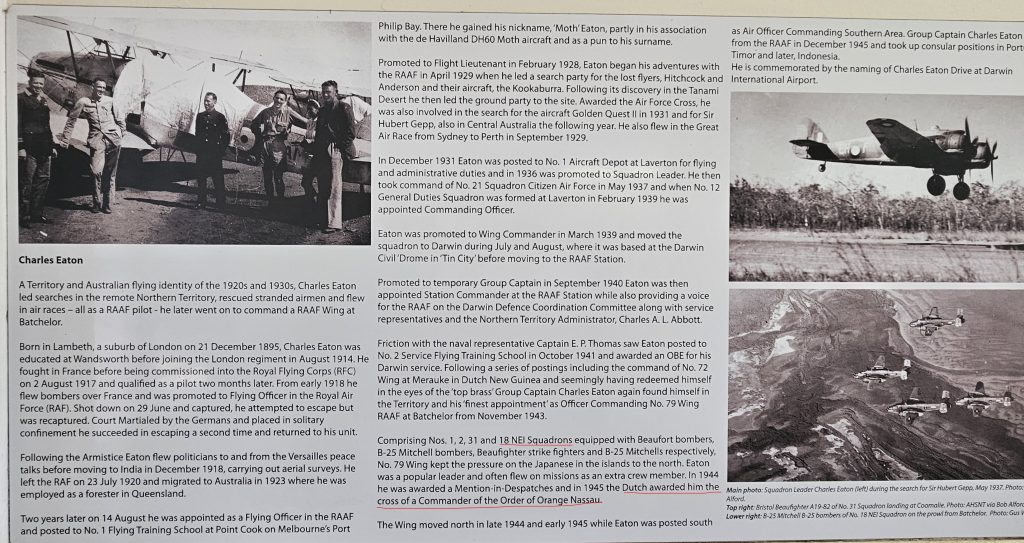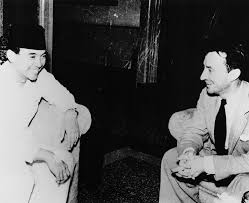After the surrender of Netherlands East Indies to the Japanese, it was the intention of the commander of the ML-KNIL General van Oyen to establish a NEI Squadron using the various aircraft and air crew who were now at Archerfield, Brisbane this included Dutch technical personnel who had been able to evacuate to Australia. Collaboration with the RAAF led a few months later to the formation of a combined squadron.
With a heavily under resourced KNIL (NEI army), van Oyen made sure that he had significant control over the formation of a Dutch squadron. He was very well connected in the Australian influential social circles, which assisted him in making the right connections to achieve his goal.
The 80 ML-KNIL members from Archerfield together with members of the RAAF now formed the 18 Netherlands East Indies Squadron/RAAF, based in Canberra, as the Archerfield airport had become too busy and therefore not suitable for training purposes. These airmen were divided into several operational groups under RAAF control. All their stores and equipment were supplied by the American Armed Forces and paid for by the Dutch. On 18 June 1942, the total number of staff of 18 Squadron consisted of 206 Australians and 242 Dutch/NEI servicemen.

Whilst stationed at Fairbairn, Canberra, the squadron undertook anti-submarine patrols along the New South Wales coastline. Gus Winkel sunk a submarine is Sydney Harbour in the early part of the war when they were doing anti-submarine patrols.
After their training in Canberra, the Squadron relocated to McDonald Airfield in the Northern Territory, with the first operational mission on 18 January 1943. Logistically, McDonald airfield was too far away from intended targets so fully laden bombed up B-25’s were forced to land in Darwin specifically to refuel. A few months later the Squadron relocated again, to Batchelor NT and remained there until the squadron relocated finally to Balikpapan in 1945 at the end of WWII. Here they were under the overall command of the No.79 Wing RAAF.
No.79 Wing RAAF
| No. 79 Wing was a Royal Australian Air Force (RAAF) wing of World War II. It was formed in December 1943 at Batchelor, Northern Territory, as part of North-Western Area Command. Led by Group Captain Charles Eaton, the wing comprised four squadrons on its establishment, the Nos. 1 and 2 Squadrons RAAF (flying Beaufort light reconnaissance bombers), No. 31 Squadron RAAF (Beaufighter long-range fighters), and No. 18 (Netherlands East Indies) Squadron (B-25 Mitchell medium bombers). No. 79 Wing took part in the New Guinea and North-Western Area Campaigns during 1944–45, eventually transferring to Balikpapan in the Dutch East Indies as the Allies advanced northward. By the end of the Pacific War, the wing was attached to the Australian First Tactical Air Force and was made up of Nos. 2 and 18 (Netherlands East Indies) Squadrons, both flying Mitchells. The latter transferred to the Netherlands Air Force in late 1945, while the former returned to Australia where it disbanded the following year. No. 79 Headquarters itself disbanded in October 1945, soon after the end of hostilities. (Source: Wikipedia) |

In January 1946 Charles Eaton was appointed Australian consul at Dili, Portuguese Timor; he commenced duty in April 1946 and moved to Batavia (Jakarta) in August 1947. He was consul-general and Australian representative on the United Nations Security Council’s consular commission during much of the period when the Dutch attempted to reimpose colonial rule on Indonesia. Eaton clashed with Dutch administrators who subsequently complained of his ‘impropriety’, but the allegation was firmly rejected in Canberra. Following the transfer of sovereignty to the Republic of the United States of Indonesia in December 1949, he became first secretary and chargé d’affaires.
The squadron was now brought to full strength with the arrival of more RAAF personnel and consisted of 40 officers and 210 men from the ML-KNIL and 8 officers and 300 men from the RAAF.
The B-25s however, did have some severe shortcomings. The reach of the planes was only just enough to fly a bombing mission to NEI. Several planes crash landed when they ran out of fuel. After many casualties and arguments Commander Fiedeldij, put it bluntly, they would not fly anymore unless they received the necessary modifications. This worked and the RAAF agreed that the planes were sent to Eagle Farm in Brisbane where they received a 300-gallon bomb bay drop tank and more and heavier calibre weapons.
They were involved in many actions across NEI and were able to show the Dutch war effort to the people in NEI. They destroyed many Japanese operations on NEI, sunk 6 Japanese ships and numerous smaller boats. These men really were amazing, they did low level bombing of shipping. That means they were just above mast height when they were attacking Japanese shipping.
More air force personnel were becoming available from the Dutch pilot training school in Jackson, USA. This allowed the Dutch, who wanted to increase the 18th, with two more squadron. The Americans agreed to deliver the pre-ordered (and pre-paid) B-25s if the Dutch were able to provide sufficient personnel. This also required additional ground personnel and this needed to be provided by the Australians. The Australians wanted this to be led by the RAAF and were keen to lay their hands on the extra planes. However, the Americans supported the Dutch and Australia eventually agreed to provide 600 to 700 staff. This was under the provision that under the White Australia Policy, only white staff would be allowed to man the squadrons. The Dutch were able to start the 2nd squadron in May 1943.
In that year under a similar arrangement between the Dutch and Australian military command a second squadron was installed, named 120 NEI Squadron RAAF. This squadron moved from Canberra to Merauke in the southern part of Dutch New Guinea – the only unoccupied territory in NEI.
Both the 18 and the 120 Squadrons were also involved in the Western Australian Emergency in March 1944.

There is an interesting story from B 25 Commander Hans de Vries.
As the war progressed, the B-25’s he and his colleagues were flying were progressively modified for the specialist attacks they were undertaking. ‘Skip Bombing’ was found to be the most effective technique against enemy shipping. The technique had been perfected in New Guinea, against an old wreck off Port Moresby. The concept of ‘skip-bombing’ was a low, flat approach to drop bombs short of the target in such a way that the bombs bounced off the water and struck nose first against the hull or superstructure of the target ship, where they detonated. The major disadvantage was heavy fire from the target; attacking low and fast meant there was no margin for error or mishap. The early B-25s lacked sufficient forward firing armament to suppress this fire. Later versions of nearly all Mitchells featured local modifications to increase the number of fixed forward firing .50 cal machine guns. As many as eight could be controlled by the pilot and co-pilot.
The planes remained operational until 1950, when the equipment from the squadron was handed over to the Indonesian Airforce.

This is a link to a transcript of a radio talk presented by ABC war correspondent Haydon Lennard who visited the Dutch Bomber Unit in Northern Australia in 1944. This must have been the 18 Squadron.
Paul Budde
Peter Dunn OAM has written a detailed history of the 18 NEI RAAF Squadron
Also thanks to Ingrid Schodel (Children of the 18th Squadron) for her assistance with the research of this article.
See also:
Gerard Johan Lugt Flight Commander at 18 NEI Squadron in Australia
Profile of Joop van Doorn former radio/telegraphist/navigator of the 18 Squadron
Harry Burgers wireless operator and air gunner
Jeff Crosbie – Australian Gunner at the 18 NEI RAAF Squadron
Personal details of some more members of the18 Squadron NEI RAAF
The “Pulk” restored B25 bomber from the 18 NEI Squadron RAAF
There are also a number of records of 18 Squadron in the Australian War Memorial archives.
The one below is from Operations Record Book for 18 Squadron NEI-AF at the National Archives

The following video shows the ceremony during which the six new officers were sworn in at the Canberra airport 30 August 1942. These officers are J. Daanen, A. Hagers, A.L.N. Swane, F. Olsen, F. Pelder en C. Busser. The function was carried out by Major Fiedeldij, commanding officer of the 18 Squadron. Source: Nederlands Instituut voor Militaire Historie
https://www.facebook.com/watch/?v=1911733265757602




First difficult year of the Squadron 1942-1943
List of casualties
Below is a list of the casualties of the Air Force of the Royal Netherlands East Indies Army.
Source: De Militaire Luchtvaart van het KNIL in de jaren 1942-1945
The following website also offers information on the Air Force of the Royal Netherlands East Indies Army. Key in Netherlands East Indies for an overview of available files.


